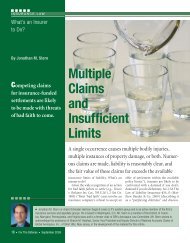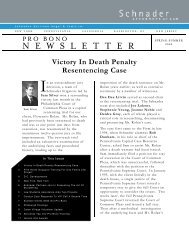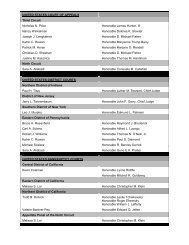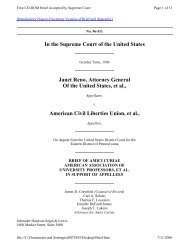the post-holocaust world and president harry s. truman
the post-holocaust world and president harry s. truman
the post-holocaust world and president harry s. truman
Create successful ePaper yourself
Turn your PDF publications into a flip-book with our unique Google optimized e-Paper software.
<strong>the</strong>ir own good, <strong>and</strong> make sure that <strong>the</strong>y got <strong>the</strong> right<br />
quantity <strong>and</strong> quality of food.<br />
But <strong>the</strong>re was ano<strong>the</strong>r rationale that was presented, namely<br />
that <strong>the</strong>re was a fear in <strong>the</strong> military that <strong>the</strong>se people would<br />
roam <strong>the</strong> countryside <strong>and</strong> kill civilians, <strong>and</strong> cause a lot of<br />
chaos <strong>and</strong> mayhem. My sense is that that was <strong>the</strong><br />
predominant rationale that was given, but certainly what we<br />
saw in “B<strong>and</strong> of Bro<strong>the</strong>rs” was ano<strong>the</strong>r rationalization.<br />
The conditions in <strong>the</strong> DP camps were usually miserable.<br />
They were terribly overcrowded. In <strong>the</strong> Truman <strong>president</strong>ial<br />
papers, <strong>the</strong>re’s a fascinating letter to <strong>the</strong> President from<br />
Nathan Strauss, in which he encloses a letter from his son,<br />
Peter, who was in <strong>the</strong> Manpower Division of <strong>the</strong> Office of<br />
Military Government in Germany – OMGUS. Peter Straus<br />
writes to his fa<strong>the</strong>r, describing <strong>the</strong> conditions in a particular<br />
camp. He talks about a staggering jam-up. He describes his<br />
camp as having been overcrowded with 1,200-1,500 people,<br />
but now housing some 3,000, people, with more arriving<br />
continuously. He describes rooms in which families of<br />
twelve are housed in one little compartment, with one single<br />
bed, one double-decker bed, no mattresses <strong>and</strong> three straw<br />
pallets on <strong>the</strong> floor. That’s just one small example, but you<br />
can multiply it across <strong>the</strong> length <strong>and</strong> breadth of <strong>the</strong> DP camp<br />
network. On top of that, so many of <strong>the</strong> DPs had to wear<br />
<strong>the</strong>ir old concentration camp uniforms. Some were told to<br />
put on SS uniforms, because those were <strong>the</strong> only clo<strong>the</strong>s that<br />
were available. In addition, <strong>the</strong>y were under armed guard,<br />
<strong>the</strong>y were not allowed to leave, <strong>and</strong> often <strong>the</strong> camps were<br />
surrounded by barbed wire. And some of those places were<br />
in fact concentration camps that had been converted to DP<br />
camps. What <strong>the</strong> conversion consisted of is very difficult to<br />
discern, but previously <strong>the</strong>y had been concentration camps,<br />
<strong>and</strong> now <strong>the</strong>y were DP camps.<br />
3







